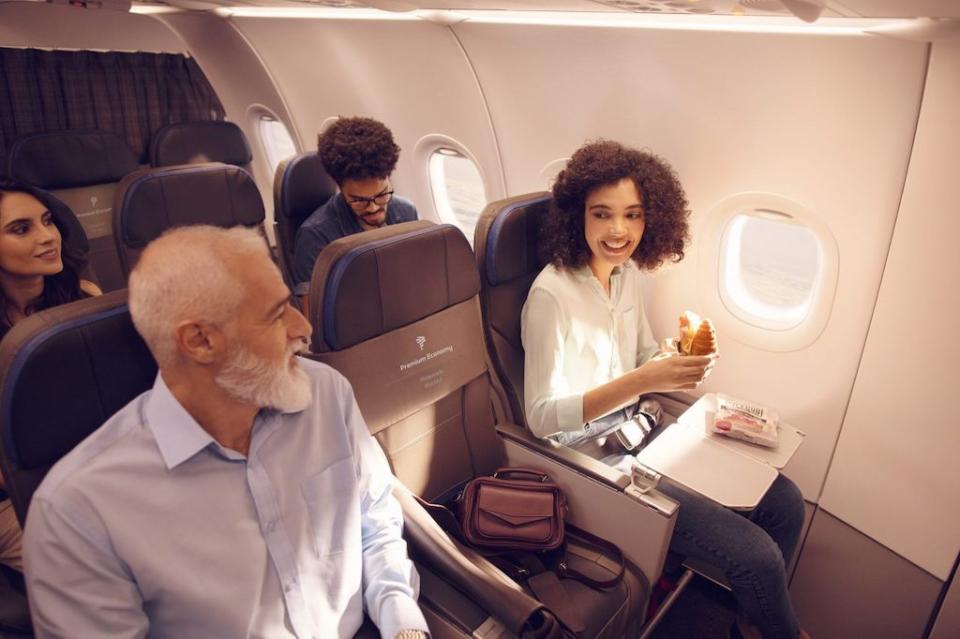Chile’s Latam Airlines Improves Premium Product Ahead of Delta Tie-Up

Chile-based airline Latam has entered 2020 on the heels of several big changes, including Delta Air Lines’ landmark $1.9 billion investment in the carrier and the news that longtime CEO Enrique Cueto will step down on March 31. But another development tucked a bit further from view is a new milestone in the carrier’s long-term strategy to improve its customer service.
Latam will add premium economy class starting March 16 across its nearly 1,300 domestic and regional short-haul routes in Chile, Argentina, Colombia, Ecuador, Peru and Brazil. This move adds a higher-end option on Airbus A320 family aircraft that only offer economy class today.
The carrier will offer premium economy class in the first three rows of the aircraft, with middle seat blocked off for added space. It will create a new class differentiated by features such as curtains, seat trim and dedicated bins. “Today we have a single cabin on domestic flights, and we’ll have now in effect two different cabins available,” Latam’s Chief Customer Officer Paulo Miranda said in an interview.
The biggest differentiator between Latam’s new premium economy class over its standard economy product will be the extra services. These include perks such as lounge access, special meal offerings, priority check-in and boarding, faster deplaning and at least one free checked bag that will come off the luggage belt first.
Network carriers have already segmented fares in Latin America to compete with the rise of low-cost rivals such as Colombia’s Viva Air and Chile’s JetSmart, which require passengers to pay extra for everything from seat selection to printing boarding passes. Latam is now focusing on appeasing travelers who might not be excited about flying economy after enjoying long-haul business amenities like lie-flat beds and fancy meals, or simply want to carry some aspects of that experience to shorter flights.
The new product will allow ensure Delta’s and Latam’s products are more aligned. Once the two airlines work out details of their partnership, customers will know they will be able to sit in a premium product on connecting flights, in both North and South America.
“We identified and heard very clearly from our customers that we had a gap in our offering,” Miranda said. “The customer that’s selecting to fly with us on premium business, they have a higher set of expectations in terms of when they fly Latam. So, this is a direct answer to those customers, and to their demand in terms of a better product with more segmentation.”
This strategy builds off what airlines in the region have already done to compete with low-cost carriers. For example, Latam already offers four types of fare classes ranging from the lowest “promo” fares to full-flexibility “top fares.” And in November, Avianca’s management told investors that it had started rolling out its own version of these so-called “branded” fares in Colombia and Ecuador.
A Smart Investment
Latam can now affordably compete for premium revenues with airlines such as Avianca, which features 12 business class seats across its Airbus narrowbodies. By blocking off seats and adding services, the plan is simpler (and likely cheaper) than a true business-class retrofit. Cost-consciousness wouldn’t be a bad idea for Latam, which recorded an $86.3 million profit in the third quarter of 2019 after losing more than $100 million in the first half of the year.
The play is a low-cost, fast way to implement a differentiated service for the premium traveler on shorter flights, according to Airline Weekly Editor Madhu Unnikrishnan.
“They’re putting their marker in the ground and saying, ‘We’re the carrier for the business traveler,’” Unnikrishnan said. “It’s a fairly low-cost way to get into the high end of the market for them.”
Bigger Strategy
While this change is a play mainly focused on adding services, it does tie into a bigger project the airline has been working on to improve the look and feel of its cabins. The carrier is putting up $400 million to retrofit a majority of its fleet, which includes new seats on A320s and A321s.
“We started [the narrow-body retrofits] last year and we are moving fast; it is a complex change in terms of all that it entails for planning and aircraft on the ground to do the work,” Miranda said. “So it’s moving along—we’re completing them as fast as we can to make sure that we get the updated product for our customers as soon as possible.”
Improving Communication
With increased segmentation can sometimes come increased confusion for passengers. The Latin American market has become increasingly complex, with so many different fare structures and ancillary services across different airlines that it can be hard to remember what’s included in a fare and what’s not. Without reading the fine print, budget-focused travelers may end up paying far more for bags, boarding passes or even just checking in than they had originally planned. On the other end of the spectrum, Latam will have to convince travelers that paying more for these new premium services on short flights is worth it.
Communicating these changes effectively through digital channels is key, Miranda said. The airline has been focused on what it calls “contextual communication,” or delivering the right message at the right time. That could be a push notification a few days before the flight reminding them their fare does not include overhead bin space, for example.
“We’re working pretty hard to make sure that we are always bringing information that is relevant to people at the right time,” Miranda said. “We will continue to look at that as the avenue to bringing forth key messages when necessary.”
Subscribe to Skift newsletters covering the business of travel, restaurants, and wellness.

 Yahoo Finance
Yahoo Finance 